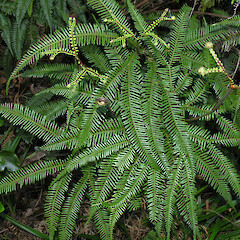Sticherus urceolatus
Common name
umbrella fern
Family
Gleicheniaceae
Flora category
Vascular – Native
Endemic taxon
No
Endemic genus
No
Endemic family
No
Structural class
Ferns
Current conservation status
The conservation status of all known New Zealand vascular plant taxa at the rank of species and below were reassessed in 2017 using the New Zealand Threat Classification System (NZTCS) – more information about this can be found on the NZTCS website. This report includes a statistical summary and brief notes on changes since 2012 and replaces all previous NZTCS lists for vascular plants.
Please note, threat classifications are often suggested by authors when publications fall between NZTCS assessment periods – an interim threat classification status has not been assessed by the NZTCS panel.
- Conservation status of New Zealand indigenous vascular plants, 2017 . 2018. Peter J. de Lange, Jeremy R. Rolfe, John W. Barkla, Shannel P. Courtney, Paul D. Champion, Leon R. Perrie, Sarah M. Beadel, Kerry A. Ford, Ilse Breitwieser, Ines Schönberger, Rowan Hindmarsh-Walls, Peter B. Heenan and Kate Ladley. Department of Conservation. Source: NZTCS and licensed by DOC for reuse under the Creative Commons Attribution 4.0 International licence.
2017 | Threatened – Nationally Critical | Qualifiers: DP, RR, SO
Distribution
Indigenous to New Zealand. South Island: recorded from the Takākā area and the Denniston Plateau. Appears to have been in Fiordland (Indian Island) in the past (Brownsey et al. 2013).
There has been some confusion over the distribution of Sticherus species in New Zealand. Perrie (2013) stated: “Populations of Sticherus tener and Sticherus urceolatus in the northern South Island had previously been mistakenly attributed to Sticherus flabellatus. We now believe that Sticherus flabellatus does not occur in the South Island, but it is common in the northern North Island.”
Also found in Tasmania.
Habitat
Recorded from shallow sandstone caves, under overhangs on steep, north-facing cliffs, and along streamsides, track cuttings and roadsides, and in more open areas on sloping river banks, at 300–600 m a.s.l. Associated species included Gleichenia dicarpa, Empodisma minus and Sticherus tener, with surrounding vegetation including Halocarpus bidwillii, Quintinia serrata, and Leptospermum scoparium. (see Brownsey et al. 2013).
Detailed description
According to Brownsey et al. (2013) “Sticherus urceolatus has fronds that are held partially upright in the form of a fan. There is a somewhat narrow angle (c. 50°) between paired proximal pinnae. The ultimate leaflet is somewhat longer than the proximal costa (mean ratio 5.7 : 1). The proximal costa either lacks, or has only one or two, leafy ultimate segments. The ultimate leaflet is narrowly elliptic in outline with the segments arising at 55–65° to the costa. The segments of the ultimate leaflets are longest near the middle, 15–27 mm long, 23 mm wide, entire or sometimes minutely serrate near the apices, and green on the undersides. There are occasional, narrow, fimbriate, brown scales along the costae, and hair-like scales on the undersurfaces. Spores measure 38–43 µm by 19–23 µm (four samples from Stockton and one from Rangihaeata, Takaka).”
Similar taxa
Sticherus tener is similar. See Brownsey et al. (2013) for a comparison of features.
Threats
Threatened by opencast mining on the Denniston Plateau (Perrie 2013).
Etymology
sticherus: In rows; from the greek sticheres; arrangement of the spore clusters
urceolatus: From the latin urceolatus (urn-shaped), a reference to the vase-shaped habit of the pinnae when growing in an exposed position.
Attribution
Fact sheet prepared by Melissa Hutchison (19 November 2022). Features section copied from Brownsey et al. (2013).
References and further reading
Brownsey PJ, Ewans R, Rance B, Walls S, Perrie LR. 2013. A review of the fern genus Sticherus (Gleicheniaceae) in New Zealand with confirmation of two new species records. New Zealand Journal of Botany 51(2): 104-115. https://doi.org/10.1080/0028825X.2013.773917
Perrie L. 2013. Would you mine a rare population? Blog on the Museum of New Zealand/Te Papa Tongarewa website. https://blog.tepapa.govt.nz/2013/04/21/would-you-mine-a-rare-population/



